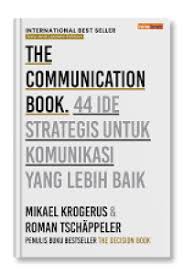Summary
Whether in personal or professional environments, the 44 brief, practical chapters in The Communication Book provide tools and ideas to help you speak, listen, and connect—that is, improve your Psychology, philosophy, or empirical data support each concept, so clarifying communication, increasing empathy, and improving effectiveness of communication.
🧠 Central Message
“Good communication develops understanding, trust, and connection rather than only conveys information.”
In every interaction, this book will enable you to grow more conscious, strategic, and deliberate.
Key Concepts from Selected Strategies
1. Four Sides of a Message
Every message consists of:
Factual (What I’m stating)
Self-revelation—that is, my revealing of myself—
Relationship: How I view you
Appeal (What I want from you) 👉 Often in miscommunication, speaker and listener concentrate on different “sides.”
2. Active Listening
Not only hear, but actively participate.
Make eye contact, nod, and ask open-ended questions.
To indicate understanding, summarize (e.g., “So you’re saying…”).
3. The Pitch on the Elevator
Clearly and fast express difficult concepts.
Apply the formula: What you do plus for whom plus the advantage.
For instance, “I help small businesses grow through digital marketing.”
4. The Rules of Commentary
Be accurate, timely, and specific, helpful.
Steer clear of blame with “I” statements.
For instance, “I noted that your late arrival to the meeting affected the agenda. Is everything in good shape?
Five: The Johari Window
One self-awareness instrument displaying:
Regarding you, what do you and others know?
Unknown, blind, or hidden? 👉 Promote self-disclosure and honest comments to raise confidence.
6. The Drama Triangle: Roles in poisonous communication
Victim, Persecutor, Rescuer. Get outside these roles to start meaningful dialogues.
7. Nonviolent Communication (NVC) Drawing on:
Observation (without judgement)
Emotions
Need
Request: “I need respect, thus I get annoyed when you interrupt me. Could we perhaps wait till I finish speaking?
8. Say “No,” efficiently.
Clear and polite is what you want.
Tell what you can do, not only what you cannot.
For instance, “I’m available Friday morning, but I can’t make it tomorrow.”
9. The Authority of Silence
Silence can be confident, create space, and call for more profound reactions.
Listen more than you talk; don’t hurry to cover every pause.
10. The Tenth Rule, Ten Seconds
Spend ten seconds pausing before reacting emotionally.
increases emotional intelligence and helps stop rash reactions.
✍️ Authorial Style
Clear, simple, and graphic.
Many concepts are clarified by graphs, diagrams, or straightforward examples.
Made for everyday use and fast learning.
“Communication isn’t just what you say—it’s how you say it, how you listen, and how you respond,” says the final insight.
Applying these 44 useful tools will help you to improve in all spheres of life by making you a more thoughtful, persuasive, and sympathetic communicator.
